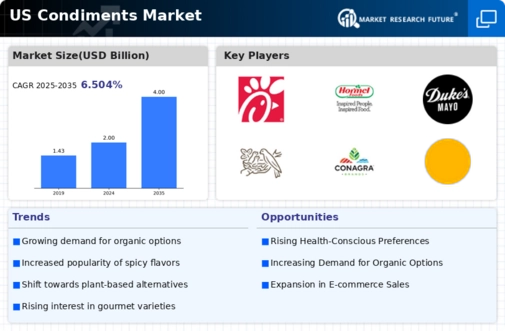Rising Demand for Ethnic Flavors
The condiments market in the US is experiencing a notable shift towards ethnic flavors, driven by the increasing diversity of the population and a growing interest in global cuisines. Consumers are increasingly seeking out condiments that reflect authentic tastes from various cultures, such as sriracha, chimichurri, and tzatziki. This trend is supported by data indicating that the ethnic condiment segment has seen a growth rate of approximately 15% over the past few years. As consumers become more adventurous in their culinary choices, the condiments market is likely to expand further, with manufacturers innovating to meet this demand for unique and bold flavors.
Convenience and Ready-to-Use Products
In the fast-paced lifestyle of many consumers, convenience plays a crucial role in purchasing decisions within the condiments market. Ready-to-use products, such as squeeze bottles and single-serve packets, are gaining traction as they offer ease of use and quick access to flavor enhancers. Recent market data suggests that the ready-to-use segment has grown by around 20% in the last year, reflecting a shift in consumer preferences towards products that save time in meal preparation. This trend indicates that manufacturers are likely to continue focusing on convenience-oriented packaging and product formats to cater to the evolving needs of busy consumers.
Increased Focus on Clean Label Products
The clean label movement is significantly influencing the condiments market, as consumers become more aware of the ingredients in their food. There is a growing demand for products that are free from artificial additives, preservatives, and high-fructose corn syrup. Recent surveys indicate that approximately 60% of consumers prefer condiments with simple, recognizable ingredients. This trend is prompting manufacturers to reformulate their products and highlight transparency in labeling. As a result, the condiments market is likely to see an increase in the availability of clean label options, appealing to health-conscious consumers who prioritize quality and authenticity.
Innovations in Packaging and Sustainability
Sustainability is becoming a key driver in the condiments market, with consumers increasingly concerned about environmental impact. Innovations in packaging, such as recyclable materials and reduced plastic use, are gaining traction as brands seek to align with consumer values. Recent data indicates that nearly 50% of consumers are willing to pay more for products that use sustainable packaging. This trend is prompting manufacturers to invest in eco-friendly solutions and communicate their sustainability efforts effectively. As the demand for environmentally responsible products grows, the condiments market is likely to see a shift towards more sustainable practices, influencing purchasing decisions and brand loyalty.
E-commerce Growth and Online Shopping Trends
The rise of e-commerce is reshaping the condiments market, as more consumers turn to online platforms for their grocery shopping. The convenience of purchasing condiments online, coupled with the ability to access a wider variety of products, is driving this trend. Recent statistics show that online grocery sales have surged by over 30% in the past year, with condiments being a popular category among consumers. This shift is encouraging manufacturers and retailers to enhance their online presence and optimize their supply chains to meet the growing demand for online shopping. As e-commerce continues to expand, it is likely to play a pivotal role in the future of the condiments market.






















Leave a Comment